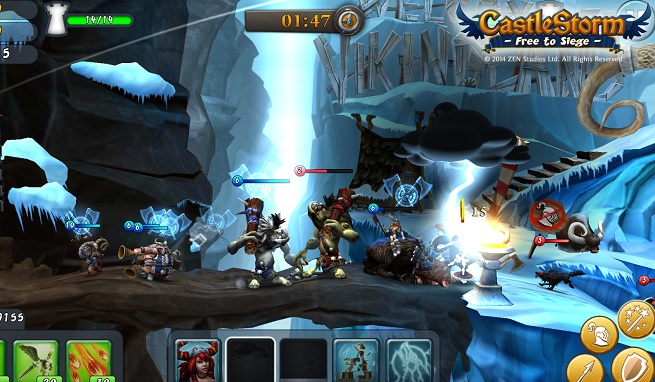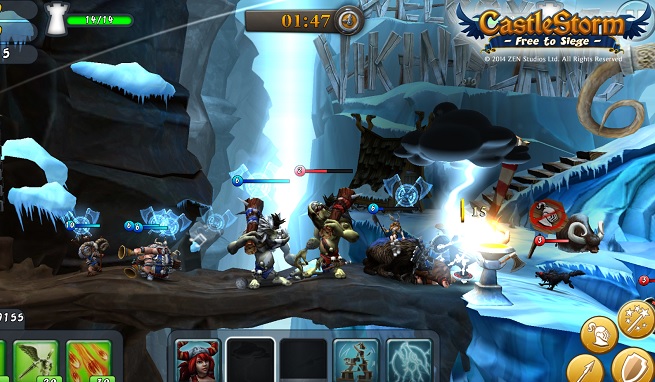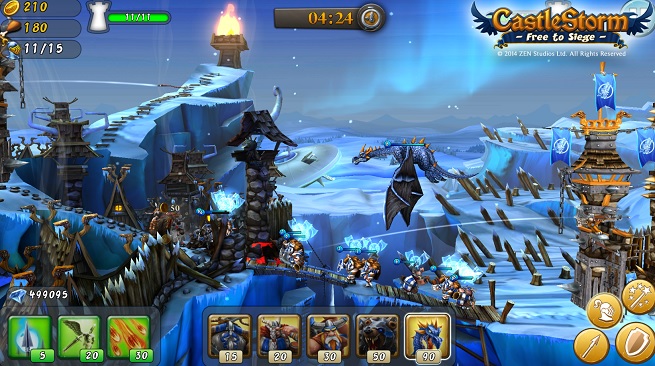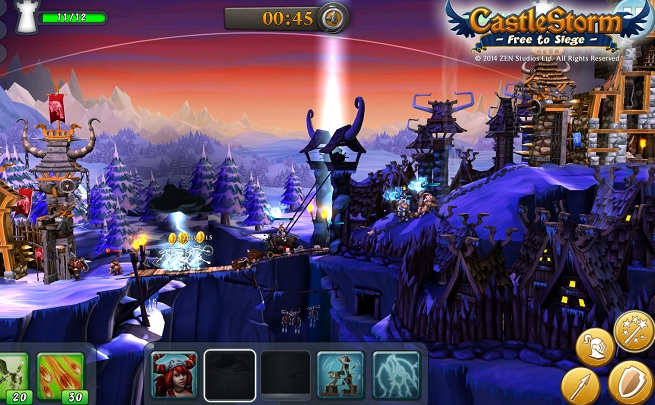CastleStorm: Free to Siege is launching on mobile devices today, and for publisher Zen Studios, getting it done was an adventure in itself.
Mel Kirk, the vice president of publishing at Budapest, Hungary-based Zen Studios, told us the tale in hopes of teaching other console and PC game developers about how to transition from making paid console and PC games to making free-to-play mobile titles. As he related the story, it became clear that it was not an easy thing to do. Yet this kind of transition is becoming critical for traditional game companies if they want to be positioned for survival in the new era of digital games.
“We’re getting our feet wet, and we’re going to see how it goes,” Kirk said in an exclusive interview with GamesBeat.
The undertaking was a sizable one for Zen, which has just 60 employees, most of whom have been making pinball games that have sold in the tens of millions. CastleStorm took just seven people to make, but it was a critical title because it diversified Zen beyond pinball.
CastleStorm launched on the PC last year as a first-party title for Xbox Live on the Xbox 360. It was a success there, so the studio adapted it to the PlayStation 3 and the Wii U. All told, CastleStorm sold more than 700,000 units. That’s a good number considering that customers had to pay good money for every single copy. Mobile games rarely have 700,000 people who pay.
“We had mobile in mind as an opportunity,” said Kirk. “But it meant adapting it to the touch screen and a different type of economy and business model.”
Zen reworked the game over the past year as a free-to-play mobile game. It had to undertake some big changes, like adapting it for a touch-screen interface. Since CastleStorm featured 2D castles with players lobbing giant rocks at each other via giant ballistas, the design lent itself to the touch screen, which has been good for physics games such as the catapult-friendly Angry Birds titles. Using swiping actions, players move their characters onto the battlefield and launch an attack on the enemy castle.
The team designed the game with sensitivity toward players who don’t want to be ripped off. Players resent games where there is a hard pay wall, where they can play for free for a little while but then have to pay to get over a big obstacle. And players hate it even more if other players can pay to win. Zen wants people who don’t buy anything to have just as big a shot at victory as those who buy things. The campaign in the mobile game is exactly the same as it is on the PC.
“There is so much negative attitude toward companies that try to do money grabs,” Kirk said. “You can go through the whole game without spending. We think it is more fun, and you do less grinding, if you spend. We tried to be very fair, and that required us to spend a lot of time thinking about that during development.”
Zen doesn’t require players to buy things that should be accessible for basic gameplay. And there are no tricks like big buttons that players might accidentally hit with their thumbs that would cause them to buy something instantly.
Of course, Kirk said he recognized it was a huge risk if players don’t see the value in buying anything. Plants vs. Zombies 2 got 25 million downloads when Electronic Arts launched it last summer, but lots of players never bothered to pay for anything in the free-to-play game.
Kirk said the company tested the beta version. Players signed up on its website. At first, Zen Studios was hoping for 1,000 players, but it found that it had more than 6,000 signed up. Those players provided some critical feedback, helping the company fix some bugs. In return, Zen is gifting a lot of crystals, or virtual currency, to those players.
Google had an ability to easily recruit beta testers through its Google+ social network. You simply send a user a private link, and they can join the beta test, sort of like a hidden release of the game.
Zen learned that it was showing too many ads. At first, it was clear that players were annoyed because Zen was showing an ad after every battle. So Zen scaled that back to showing an ad after every three battles.
“We scaled that back,” Kirk said. “People were very comfortable with that. If we had launched with an ad after every battle, people would have just quit, and it would have taken us a long time to figure that out.”
Zen hunted down some ad networks that wanted to get certain brands in front of players who have the right demographics. Zen only gets paid for those ads if the users take action, like downloading something or accepting some kind of incentivized offer.
Problems arose with video ads for people who had smartphones with slower 3G Internet access. So Zen showed those players static ads instead.
The ads are a good source of revenue to monetize the players who don’t spend anything. But equally gratifying was that players saw value in buying things. Zen exited the beta test with a solid idea of the lifetime value of a customer, or the average amount of money it would get from a player over the life of the playing time. That means that Zen knows how much it should spend acquiring users through paid advertising when the time comes to do that.
“The most useful feedback to us was the economy,” Kirk said. “The best feedback was on how to present the choice to buy things to players without coming off as greedy.”
One of the things Zen created was daily rewards for coming back to the game every day. It made the rewards meaningful to players.
Zen changed the price of virtual items based on the analytics, which it got at first from the mobile analytics firm Flurry. But over time, Zen decided to use one of its own engineers to create a custom analytics system. So Zen has its own dashboard that measures things that are critical in its own game, like where players get stuck. That data is available on a real-time basis, and Zen can push notifications to players if it wants to do so.
“We built it ourselves, and that’s why it took a while,” Kirk said. “We contracted with some data scientists, and we hope to hire them.”
Zen has also met with outside vendors such as Yvolver, which opened the company’s eyes to things like predicting when players might quit a game and what to do about rewarding them.
The company is launching CastleStorm: Free to Siege today on the App Store, Google Play, and Amazon. It is a full experience with four campaigns, four nations, distinct troop classes, and up to 150 battles. There are eight playable hero characters and a bunch of weapons, spells, and bonus rooms.
Kirk said the company will operate the game as a service. It has a six-month roadmap for content updates, and it can prepare more if the game is a big hit on mobile. Zen will work with other developers with similar games on cross-promotion, which allows the company to exchange traffic without spending money on user acquisition. At some point, Kirk expects to spend money on user acquisition. The team plans to run test campaigns to see what sources of users will work.
Zen has worked with the platform owners to get its shot at being featured on different platforms.
“You should never lose sight of keeping them up to date,” Kirk said. “You have to maintain a good relationship with them.”
Now Zen is exploring making its core pinball games free-to-play.
VentureBeat's mission is to be a digital town square for technical decision-makers to gain knowledge about transformative enterprise technology and transact. Learn More





